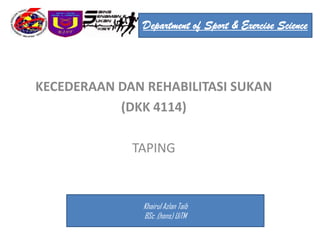
Bab 10 taping
- 1. Department of Sport & Exercise Science KECEDERAAN DAN REHABILITASI SUKAN (DKK 4114) TAPING Khairul Azlan Taib BSc .(hons) UiTM
- 2. HOW TO PREPARE THE SKIN Before apply the tape, we need to prepare the area to be taped by: • Shaving the area - for best results, wet-shaving the skin 12 hours before. • Cleaning the area by using a tape remover to remove the body oil. • Covering any rashes or broken skin with a non-stick wound pad. • Applying an underwrap to the area, (optional). An underwrap will help protect .
- 3. WHERE TO APPLY THE TAPE • Joints are normally strapped in their “at rest” position. • Hold the roll in one hand and pull the tape off with the other hand, then apply gently.
- 4. HOW TIGHT SHOULD THE TAPE BE? • Flexing the muscles when applying the tape will help you get the correct tension. • Check that the tape is not too tight by pinching the skin below the tape for a few seconds. • The skin should return to its normal colour when released. • If the tape is too loose, it will not support the joint. • If it is too tight, then it could cut off the blood supply. • If numbness and tingling result, remove tape or bandage and reapply with reduced tightness.
- 5. HOW MUCH TAPE TO APPLY • For maximum strength, overlap each layer of strapping tape by 1/3-1/2. • The amount you use depends upon the amount of support you need. • If you use too little, then you are not providing enough support to the joint. • If you use too much, then you could reduce the mobility of surrounding muscles.
- 6. WHEN TO REMOVE THE TAPE • Remove the tape as soon as you have finished training or playing.
- 7. HOW TO REMOVE THE TAPE • Ideally, remove the tape using bandage scissors. • Place the scissors over a soft part of the limb (not over the bone) then slide under the tape and cut. • Peel down over the top of the tape. • Do not peel at right angles away from the limb. • Peel gently and evenly - do not rip. • A tape remover can help to quickly and painlessly remove tapes and bandages. • It also helps to remove any tape residue from the skin.
- 8. WHICH TAPE TO USE • To restrict joint movement, use a rigid strapping tape. USE: PRODUCT: Preventative ankle taping Rigid Strapping Tape 38mm or 50mm for large joints Treatment such as injured ankle, elbow, Rigid Strapping Tape 25mm or 12.5mm fingers Treatment such as injured shoulder, knee, Rigid Strapping Tape 50mm feet
- 9. WHICH TAPE TO USE • To compress and support joints or muscles, use an elastic adhesive bandage. USE: PRODUCT: For strong compression when returning Elastic Adhesive Bandage 75mm from injury, eg sprained knee. To be used over rigid tape. For initial compression, eg, acute ankle Elastic Adhesive Bandage 50mm sprain Treatment such as injured shoulder, knee, Rigid Strapping Tape 50mm feet
- 10. BASIC TAPING METHODS • A- Anchor - provides a firm base to attach the other 38mm or 50mm tapes. • B- Stirrup - a vertical “U” piece of tape, supporting either side of the ankle. • C -Spur - a horizontal stirrup that holds the ankle in position.
- 11. • D- Basket-weave - Stirrups and spurs in half overlapping layers to build a pattern. • E -Locking straps - short circular tapes to cover all exposed skin and lock down the tape job. • F- Foam padding - used to fill in hollows, compress swelling and pad sensitive areas.
- 12. • G- Figure of six - to support and reinforce one side of the ankle. Starts as a stirrup and crosses to form a six. • H- Interlocking sixes - the over-lapping tapes provide excellent support to one side of the joint.
- 13. • I- Half-Heel Lock - 38 or 25mm rigid tape is applied over the finished tape job to firmly lock in the ankle joint. • J- First Half-Heel Lock - the tape makes a ‘U’ to lock in one side of the heel. • K- Second Half-Heel Lock - opposite to the first. Supports the other side and further restricts ankle movement.
- 14. • L- Figure-8 Bandage - used with a compression bandage for RICER. • M- Figure-8 - also used with a 75 or 50 mm elastic bandages for strong support. • N- Spica - the thumb spica is a repeated figure 8 in 25 mm rigid or elastic tape.
- 15. • O- Elastic and Rigid Tape Together - a combination of an Elastic Adhesive Bandage and Rigid Strapping Tape provides optimal support. • P- Full Heel Lock In 75mm Elastic - another way of overwrapping rigid tape for firm support. It is like two half heel locks without stopping. • Q- Spiral taping - (white tape) complete the overwrapping technique to completely encase the Rigid Tape.
- 16. T.Q
